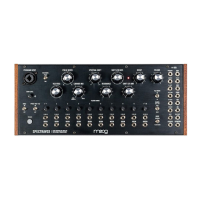27
SPECTRAL SHIFT is an innovative feature that sets Spectravox apart from all other analog vocoders.
Throughout the initial vocoding work done by Homer Dudley in the 1920s, its refinements through
the years by the Department of Defense, and its musical refinements by Wendy Carlos, Bob Moog,
and many other electronics manufacturers, the filter bands of a vocoder were always fixed in place.
Because of the unique design of Spectravox’s filters, however, they contain variable RESONANCE and
their center frequencies can be moved up and down the frequency spectrum via SPECTRAL SHIFT.
The ability to move the Spectravox filters and adjust their resonance makes Spectravox an extremely
powerful spectral processing tool. Only the synthesis filters move via SPECTRAL SHIFT—the analysis
filters stay at their fixed frequencies—so you can use SPECTRAL SHIFT to map and shape sounds
diagonally across the frequency spectrum. Adding to the sound design possibilities, SPECTRAL SHIFT
may be modulated via an internal triangle wave LFO or externally via CV.
SPECTRAL SHIFT
SHIFT LFO RATE
RESONANCE
SHIFT LFO AMT
SPECTRAL SHIFT
SPECTRAL SHIFT
This sets the position of all 10 synthesis filters. At zero (12 o’clock) all 10
synthesis filters are located at the frequencies listed above in the FILTER
BANDS section and are therefore aligned with all 10 analysis filters. Moving
SPECTRAL SHIFT above 12 o’clock jointly shifts all 10 filters up the frequency
spectrum, while moving SPECTRAL SHIFT below 12 o’clock shifts them down.
SPECTRAL SHIFT moves all 10 filters simultaneously—they are always fixed in
place in relation to each other.
SHIFT LFO RATE
This sets the rate of the internal triangle LFO used to modulate SPECTRAL
SHIFT. Range is very slow (approximately 0.05 Hz) at its minimum and audio
rate (around 500 Hz) at its maximum.
RESONANCE
This controls the resonance of all 10 filters in the synthesis filter bank jointly.
Turning RESONANCE up will increase the emphasis of each filter, adding more
energy at each filter’s center frequency. At maximum RESONANCE each filter
will have a prominent resonant peak and be near (but not at) self-oscillation.
Turn RESONANCE down to decrease the resonant peak of all 10 filters.
SHIFT LFO AMT
This sets the depth of modulation of SPECTRAL SHIFT by the SHIFT LFO. At
a minimum SPECTRAL SHIFT is unaected by the LFO and at a maximum the
SHIFT LFO sweeps SPECTRAL SHIFT over a very wide range.

